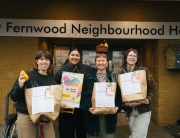Accessing the foods you need and desire can be an important aspect in feeling settled in a community. Some newcomers, such as refugees, may look to be connected with local and healthy food, particular culturally relevant ingredients or even just grocery stores in general. The Inter-Cultural Association of Greater Victoria (ICA) provides services for immigrant and refugee newcomers in Victoria. They offer settlement services, English classes and workshops to help build community and create connections across cultures. Recently food access has been an area of interest for the ICA. A recent project in collaboration with the Compost Education Centre (CEC) and LifeCycles called “Growing Food Close to Home”, involved a series of workshops related to food production and preparation.
Enter four Geography students taking the course “Mapping Edible Geographies” at the University of Victoria. This course sets the table for conversations around food systems and access. These students are learning first-hand about community based participatory research, as well as the process of community mapping. In short, this type of mapping involves co-creating an impactful, visual resource, with the direct input of a community.
These four community mappers have been workshopping a food access map with a group of English students at the ICA. With guidance from the ICA and the CEC, the UVIC students hope to bridge newcomers with places to access their desired food, including healthy and local foods. The map aims to be a spatial representation of answers to questions like: Where can I learn to grow food in this climate? Where can I access spices and ingredients that I prefer?
The final map will be presented November 30, 2016 at the Legacy Art Gallery at 6:30 pm, alongside other class projects that address a variety of community needs. The map will be available in print and online for use by newcomers, and anyone interested in food accessibility in Victoria!






